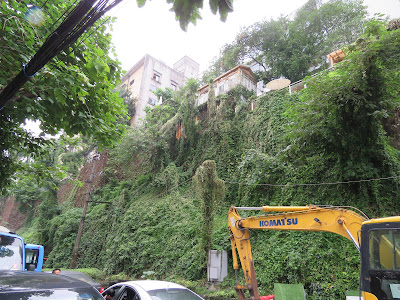Tough vine with tenuous grip on Madeira
The Madeira Vine, Anredera cordifolia, grows happily in Clifton Hill (Australia), Christchurch (New Zealand) and, in these images, in Chongqing (China). It also thrives in places not starting with 'c', particularly if there is a fence or shed to clamber over. But does it grow in Madeira, the group of four islands to the west of Morocco and part of Portugal?
If you don't know this vine, its a vigorous climber with shovel-shaped leaves and in spring dangling clusters of small white to purple flowers. In Chongqing, where I took these photos, it was a common covering of street-side retaining walls and buildings. Often weedy and neglected, but also celebrated and an occasional selfy background in places such as this (highly recommended) coffee joint called Lazyfish, in the Chongqing suburb of Eling.
At first I couldn't remember its name so my Chinese friends whipped out their plant identification app (I couldn't find or load this app due to language incompatibilities on my phone). Which worked, confirming for us that this was the notorious Madeira Vine.
So what about Madeira? Well, as explained by Arthur Lee Jacobson, despite the connection with Madeira in its English (and Spanish and French) common name, it is native to the central parts of South America (including Bolivia, Paraguay, Uruguay and parts of Brazil and Argentina).
It was introduced into the UK in 1835 and in southern Europe even earlier, soon becoming 'naturalised' through much of Europe. Jacobson doesn't know why it gathered up the descriptor Madeira but one account he cites does suggest the plant was first established in Madeira before it made its way back to the Americas.
So perhaps, and I don't know, it just happened to have been noticed in Madeira by those who ended up coining and promulgating the common name in the rest of Europe. That's the way these things can happen.
In Australia, and I gather many other places, it doesn't set viable seed, instead relying on subterranean and aerial tubers - the latter, best described as knobbly, are produced where the leaves join the main stem. That form of reproduction and dispersal serves it well. It is an aggressive and damaging weed throughout much of Australia and New Zealand, and elsewhere in the world.
Madeira Vine can smother and kill native vegetation and in fact the knobbly tubers may be part of the problem. It has been suggested the weight of these may be responsible for the collapse and ultimate death of the host plant.
So the leaves are useful, as a spinach substitute. The flowers don't serve much purpose for the plant but they are not unattractive when white, and more so when they mature to that brownish purple colour not uncommon in mosquito and midge orchids in Australia.
Notes: Map of actual (red dots) and potential (blue shading) of Madeira Vine in Australia is from a Queensland Department of Agriculture and Fisheries Fact Sheet. The spelling of 'distribuiton' is theirs.








Comments